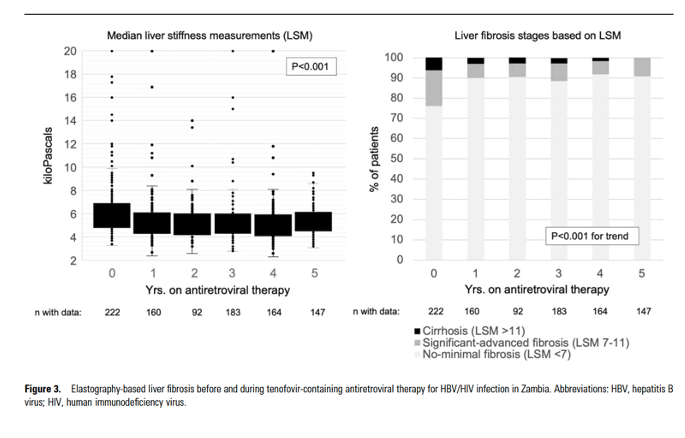| |
Long-term Hepatitis B and Liver Outcomes Among Adults Taking Tenofovir-Containing Antiretroviral Therapy for HBV/HIV Coinfection in Zambia - encourages earlier treatment in HBV monoinfection
|
| |
| |
Clinical Infectious Diseases, 24 November 2023
Download the PDF here
"In summary, in a sentinel HBV/HIV coinfection cohort in Zambia, long-term retention and adherence to tenofovir-based ART led to significant reduction in markers of liver disease, no cases of HCC, and seroclearance of HBsAg in 15.4% at 5 years."
"This not only further validates the need for universal HBV therapy in HIV, but it may support the need to explore the benefits of earlier treatment initiation in HBV monoinfection. Expanding current guidelines for antiviral therapy in HBV monoinfection is a major point of discussion in East and Southern Africa, where providing tenofovir-based therapy is less costly and less complex than providing the recommended package of lab and radiology tests to determine treatment eligibility."
Abstract
Background
Long-term outcomes of tenofovir-containing antiretroviral therapy (ART) for hepatitis B virus (HBV)/human immunodeficiency virus (HIV) coinfection were evaluated in Zambia.
Methods
A prospective cohort of adults with HIV and hepatitis B surface antigen (HBsAg)-positivity was enrolled at ART initiation. On tenofovir-containing ART, we ascertained HBV viral load (VL) non-suppression, alanine aminotransferase (ALT) elevation, serologic end-points, progression of liver fibrosis based on elastography, and hepatocellular carcinoma (HCC) incidence. We also described a subgroup (low HBV VL and no/minimal fibrosis at baseline) that, under current international guidelines, would not have been treated in the absence of their HIV infection.
Results
Among 289 participants at ART start, median age was 34 years, 40.1% were women, median CD4 count was 191 cells/mm3, 44.2% were hepatitis B e antigen-positive, and 28.4% had liver fibrosis/cirrhosis. Over median 5.91 years of ART, 13.6% developed HBV viral non-suppression, which was associated with advanced HIV disease. ALT elevation on ART was linked with HBV VL non-suppression. Regression of fibrosis and cirrhosis were common, progression to cirrhosis was absent, and no cases of HCC were ascertained. HBsAg seroclearance was 9.4% at 2 and 15.4% at 5 years, with higher rates among patients with low baseline HBV replication markers.
Conclusions
Reassuring long-term liver outcomes were ascertained during tenofovir-based ART for HBV/HIV coinfection in Zambia. Higher than expected HBsAg seroclearance during ART underscores the need to include people with HIV in HBV cure research.

|
|
| |
| |
|
|
|